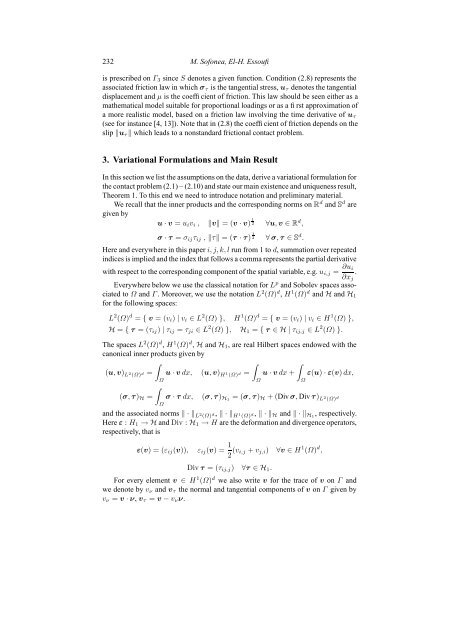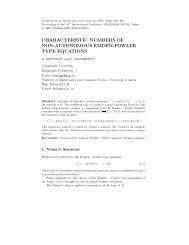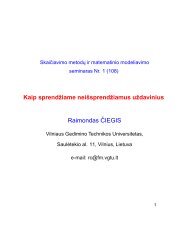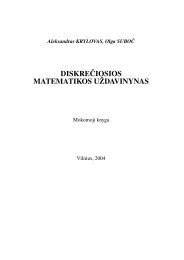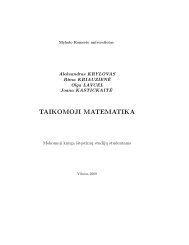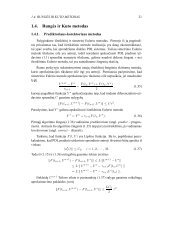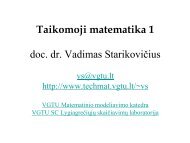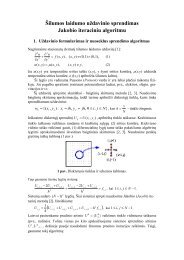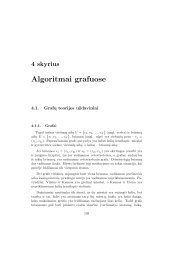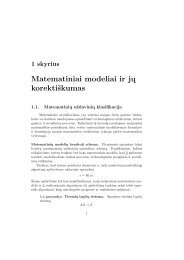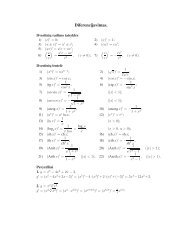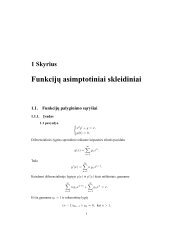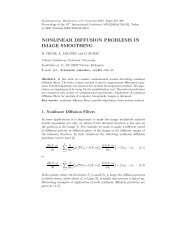a piezoelectric contact problem with slip dependent coefficient of ...
a piezoelectric contact problem with slip dependent coefficient of ...
a piezoelectric contact problem with slip dependent coefficient of ...
Create successful ePaper yourself
Turn your PDF publications into a flip-book with our unique Google optimized e-Paper software.
232 M. S<strong>of</strong>onea, El-H. Essoufiis prescribed on Γ 3 since S denotes a given function. Condition (2.8) represents theassociated friction law in which σ τ is the tangential stress, u τ denotes the tangentialdisplacement and µ is the <strong>coefficient</strong> <strong>of</strong> friction. This law should be seen either as amathematical model suitable for proportional loadings or as a first approximation <strong>of</strong>a more realistic model, based on a friction law involving the time derivative <strong>of</strong> u τ(see for instance [4, 13]). Note that in (2.8) the <strong>coefficient</strong> <strong>of</strong> friction depends on the<strong>slip</strong> ‖u τ ‖ which leads to a nonstandard frictional <strong>contact</strong> <strong>problem</strong>.3. Variational Formulations and Main ResultIn this section we list the assumptions on the data, derive a variational formulation forthe <strong>contact</strong> <strong>problem</strong> (2.1) – (2.10) and state our main existence and uniqueness result,Theorem 1. To this end we need to introduce notation and preliminary material.We recall that the inner products and the corresponding norms on R d and S d aregiven byu · v = u i v i , ‖v‖ = (v · v) 1 2 ∀u, v ∈ R d ,σ · τ = σ ij τ ij , ‖τ‖ = (τ · τ ) 1 2 ∀ σ, τ ∈ S d .Here and everywhere in this paper i, j, k, l run from 1 to d, summation over repeatedindices is implied and the index that follows a comma represents the partial derivative<strong>with</strong> respect to the corresponding component <strong>of</strong> the spatial variable, e.g. u i,j = ∂u i∂x j.Everywhere below we use the classical notation for L p and Sobolev spaces associatedto Ω and Γ . Moreover, we use the notation L 2 (Ω) d , H 1 (Ω) d and H and H 1for the following spaces:L 2 (Ω) d = { v = (v i ) | v i ∈ L 2 (Ω) }, H 1 (Ω) d = { v = (v i ) | v i ∈ H 1 (Ω) },H = { τ = (τ ij ) | τ ij = τ ji ∈ L 2 (Ω) }, H 1 = { τ ∈ H | τ ij,j ∈ L 2 (Ω) }.The spaces L 2 (Ω) d , H 1 (Ω) d , H and H 1 , are real Hilbert spaces endowed <strong>with</strong> thecanonical inner products given by∫∫∫(u, v) L2 (Ω) = u · v dx, (u, v) d H1 (Ω) = u · v dx + ε(u) · ε(v) dx,dΩΩΩ∫(σ, τ ) H = σ · τ dx, (σ, τ ) H1 = (σ, τ ) H + (Div σ, Div τ ) L 2 (Ω) dΩand the associated norms ‖ · ‖ L 2 (Ω) d, ‖ · ‖ H 1 (Ω) d, ‖ · ‖ H and ‖ · ‖ H1 , respectively.Here ε : H 1 → H and Div : H 1 → H are the deformation and divergence operators,respectively, that isε(v) = (ε ij (v)), ε ij (v) = 1 2 (v i,j + v j,i ) ∀v ∈ H 1 (Ω) d ,Div τ = (τ ij,j ) ∀τ ∈ H 1 .For every element v ∈ H 1 (Ω) d we also write v for the trace <strong>of</strong> v on Γ andwe denote by v ν and v τ the normal and tangential components <strong>of</strong> v on Γ given byv ν = v · ν, v τ = v − v ν ν.


